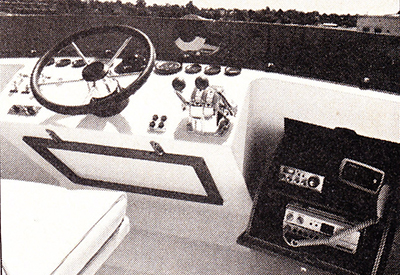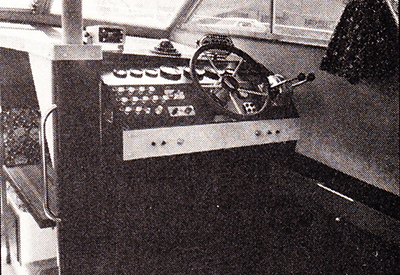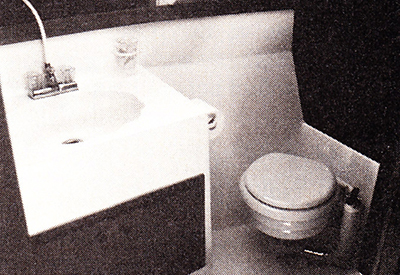Fairline 32
Andy Adams
A fly bridge twin with solid performance and a slick interior.
We couldn’t have asked for a better day to test the Fairline 32 at Niagara-on-the-Lake, Ont. The Niagara river just above Lake Ontario is a perfect setting for Gillingham’s Yacht Basin, lying directly across from Youngstown, N.Y. in one of Canada’s prettiest historic areas. The beautifully restored houses and forts made an excellent backdrop for cruising in this modem power yacht.
Unlike most of our Power Report subjects, the Fairline was fully equipped with options such as fly bridge cover, spotlight, stereo, fenders and holders, flagstaff, and screens. The proud owner was Jim Blair of Niagara-on-the-Lake. It was a pleasant change from the standard trim we usually see on our test boats.
Also on hand for the occasion were Gary Vitt, president of Fairline Boats Ltd., and John Blair, Jim’s brother and owner of Blair Mower, Marine & Cycle where the 32 was bought. All in all, a record number of participants for a Power Report.
 Even with a crew this size the Fairline turned in an admirable performance on our top-speed test. Bear in mind that this is a 10,700 lb boat with 135 gals of fuel, 52 gals of water and 12 gals of hot water so she’s no lightweight despite a pair of 225-hp engines. You might also be interested to know that the performance figures were taken without using the trim-tabs at all, and the Volvo stem-drives were not equipped with power trim or tilt.
Even with a crew this size the Fairline turned in an admirable performance on our top-speed test. Bear in mind that this is a 10,700 lb boat with 135 gals of fuel, 52 gals of water and 12 gals of hot water so she’s no lightweight despite a pair of 225-hp engines. You might also be interested to know that the performance figures were taken without using the trim-tabs at all, and the Volvo stem-drives were not equipped with power trim or tilt.
Wide open at 4,500 rpm, the 32 footer was showing 37.5 mph on radar. That’s good hustling for a boat this size, yet she wasn’t crashing over the waves and nothing seemed at all strained. Few owners would ever run a boat like this wide open all the time, but it’s nice to know you can beat a storm back to port. The twin 225s are standard; 260s are optional.
The 32 had trim-tabs that were not really needed for average running conditions, thanks to good hull design, but they could be employed to alter the hull’s ride attitude at really slow speeds, keeping the boat planing almost down to 2,000 rpm. The tabs were also useful for trimming out list, if the boat was riding on one side with a badly distributed load or strong winds. This is what trim-tabs were intended for, but too often they are employed to correct running faults in hulls that are badly drawn or balanced. The Fairline 32 is neither.
 During the tests there was only one area in which performance left something to be desired. While the boat would manage a tight turn quite nicely, the outside stem-drive would usually cavitate. This is a common characteristic of twin stem-drives and most owners just live with it, but regular cavitation will cause paint-stripping and prop-pitting.
During the tests there was only one area in which performance left something to be desired. While the boat would manage a tight turn quite nicely, the outside stem-drive would usually cavitate. This is a common characteristic of twin stem-drives and most owners just live with it, but regular cavitation will cause paint-stripping and prop-pitting.
There was also slight cavitation with the boat planing at heavy throttle. The boat has a fair amount of windage, but that’s a trait of all high planing boats and is well handled by the twin counter rotating Volvos. Light application of opposite thrust will spin the boat easily.
The steering itself was lovely on plane and despite the two stations, never seemed to bind or load up and was quite accurate as speeds increased. Low-speed tracking was fair with some off-plane wandering, but that could be attributed to the two station steering which was a trifle too light for precision.
The hydraulic steering has no engine driven pump to assist the driver. The result is light. easy steering with no drag on either engine. These Volvos were not equipped with power trim. Of course there is a tilt to bring up the stern drive for storage and prop maintenance. Fewer accessories mean less chance of breakdown, and less demand for engine-power to run accessories.
 Again it is a credit to the designer that no accessories are needed to make this an efficient running, easily driven hull. The stem-drives are always trimmed to the best all-around setting by use of a tilt pin, and certainly the system certainly works well here.
Again it is a credit to the designer that no accessories are needed to make this an efficient running, easily driven hull. The stem-drives are always trimmed to the best all-around setting by use of a tilt pin, and certainly the system certainly works well here.
The flying bridge was equipped with full instrumentation and controls, as well as a depth-sounder and radio, nicely built into a locking fold up bin to protect the equipment from weather and theft. The instruments were mounted flat but no problems with glare were encountered and everything fell readily to hand: all in all a nicely set-out control centre with a commanding view.
There were wrap-around seats for passengers to port and aft of the bridge with a centre mounted helm seat that could be adjusted fore and aft to accommodate different sizes of drivers. The whole area is protected from wind and spray by a very effective reverse-flow air spoiler that makes the bridge the best place to ride when under way.
 The second helm-station is in the main saloon. In the test boat, the helm-seat here had been omitted. This station was well set-up for standing operation and the seat was a small sacrifice considering the extra interior room its removal liberated. Aside from that, the interior helm-station was the same as the upper station with the addition of a fuel gauge and a gas vapour detect or plus, of course, three windshield wipers and their controls. Changing from one station to the other requires that the engines be shut down and restarted and that the steering be switched to that station as well.
The second helm-station is in the main saloon. In the test boat, the helm-seat here had been omitted. This station was well set-up for standing operation and the seat was a small sacrifice considering the extra interior room its removal liberated. Aside from that, the interior helm-station was the same as the upper station with the addition of a fuel gauge and a gas vapour detect or plus, of course, three windshield wipers and their controls. Changing from one station to the other requires that the engines be shut down and restarted and that the steering be switched to that station as well.
While I put a lot of emphasis on a boat ‘s efficiency and performance, people buying a boat like this are often more concerned with interior accommodation.
Rain or shine, the Fairline has a pleasant three-part cabin layout and generous accommodation for its skipper and crew. There is a full-width sliding glass door between the main saloon and the aft deck that brings in light and lots of air while creating an airy atmosphere that I liked very much. This is becoming a popular feature and it’s easy to see why. Large cabin windows add to the effect and it’s well worth noting that there are full screens for all windows, velcro fastened and mounted from the inside. This is one of several well thought out aspects of the Fairline’s finish work.
Along the starboard cabin side there is storage behind sliding doors and this side is also clear of built-ins, allowing the owner to place folding deck chairs, as Jim Blair had, or place anything else they wish in a large open space. There is excellent headroom here too, and good ventilation from all the windows.
There is a folding couch on the port side, removable as well for even more space; it folds down into a queen -sized bed, making the saloon as comfortable as any bedroom. The entire area is carpeted in a shag (medium blue in the test boat) that looks attractive and offers good sound insulation. The deck head is covered in a synthetic material that looks like beige suede and gives a handsome finished appearance.
 andy adAnother good feature is the large under-floor storage area in the main saloon. There is a lifting hatch revealing a huge area for gear as large as an inflatable life-raft. It’s nice to see safety so well integrated into the basic design. Stepping down forward of the helm-station, we find the galley and dinette. Our test boat was equipped with a three burner alcohol stove and oven and a Norcold electric refrigerator with stainless-steel sink above. Again, there is quite a bit of storage space surrounding this area but not much counter space. For basic food preparation, the dinette table would be used. It’s right at hand so that’s no problem, and the two benches seat four people comfortably.
andy adAnother good feature is the large under-floor storage area in the main saloon. There is a lifting hatch revealing a huge area for gear as large as an inflatable life-raft. It’s nice to see safety so well integrated into the basic design. Stepping down forward of the helm-station, we find the galley and dinette. Our test boat was equipped with a three burner alcohol stove and oven and a Norcold electric refrigerator with stainless-steel sink above. Again, there is quite a bit of storage space surrounding this area but not much counter space. For basic food preparation, the dinette table would be used. It’s right at hand so that’s no problem, and the two benches seat four people comfortably.
The dinette converts to a double berth and has storage under the seats but isn’t as light and airy as the main cabin and it cannot be closed off.
Forward of the galley is a V-berth cabin with a sliding teak door and large windows. More storage under the bunks is available and there is a shelf surrounding the whole area for odds and ends. The berths are not especially large for adults but more than adequate for children.
One of the 32’s most endearing features is the very spacious head with sink, cupboards, head and shower all in an enclosure that has ventilation and over six feet of headroom everywhere without intrusions or odd shapes.
Throughout the Fairline, there is evidence of careful planning and high quality materials and workmanship. The mahogany trim is very tasteful and situated where it will not be subject to undue deterioration. The accommodations will suit a family well, and the hull’s sea-keeping characteristics and performance make the 32 an excellent all-around boat.
There are lots of handrails placed where they will serve best, and features like hydraulic hatch-lifters for the engine hatches make this an easy boat to own and enjoy. Another nice touch are the bumper baskets on the all welded stainless-steel bow rail which looks neat and solves the age old problem of where to put the fenders when you’re under way. The test boat had the optional electric remote-control spotlight worth its weight when you come to unfamiliar landings at night – and the teak swim platform is nicely finished with a boarding ladder.
Originally published in Canadian Yachting’s September 1979 issue.
Specifications:
Length – 32 ft 2 in
Beam – 10 ft 10 in
Weight – 10,700 lbs
Fuel Capacity – 135 gallons
Water Capacity – 52 gallons
HOT Water Capacity – 12 gallons
Engine – Twin Volvo 225hp stern drives.
Photo Captions:
Photo 1 – Fairline 32 is built in Niagara Falls to a British design. The same line is solid in Britain and Europe.
Photo 2 – Electronic gear is well protected.
Photo 3 – Lower helm seat was removed.
Photo 4 – Head with shower for fix footers.
Photo 5 – Galley is short on counter space.
Photo 6 – The Fairline’s balanced, fair hull rode well without trim tabs.






















